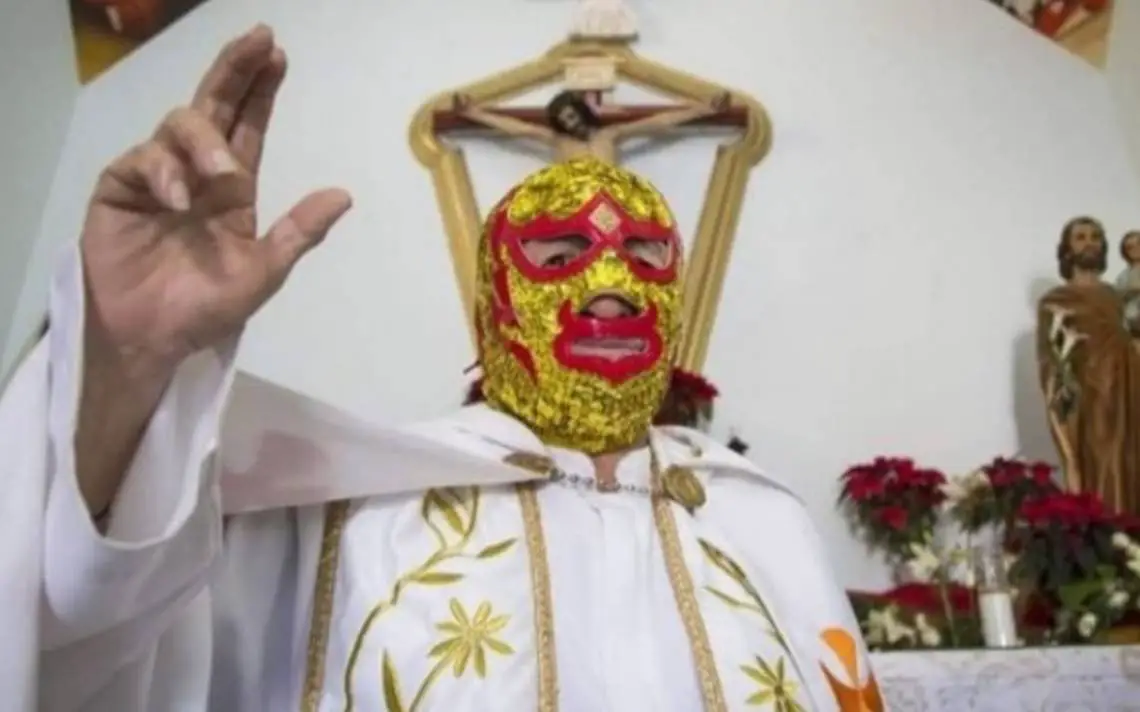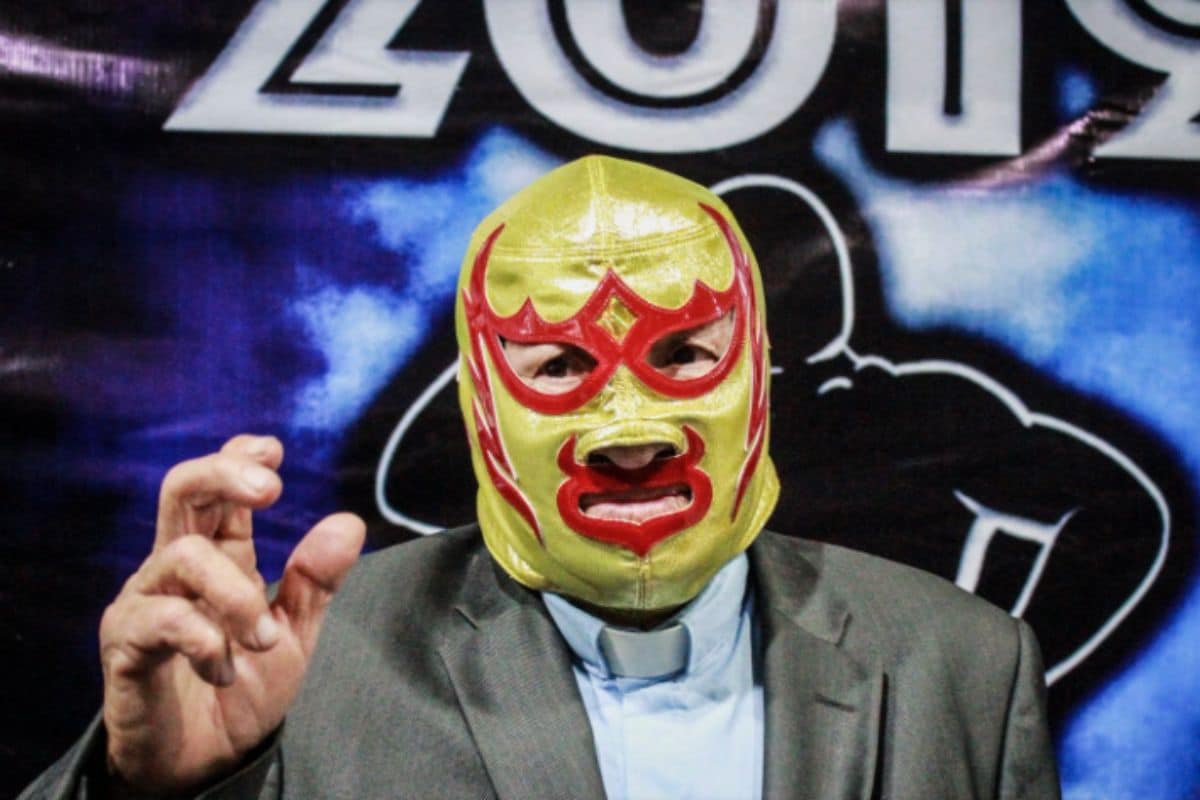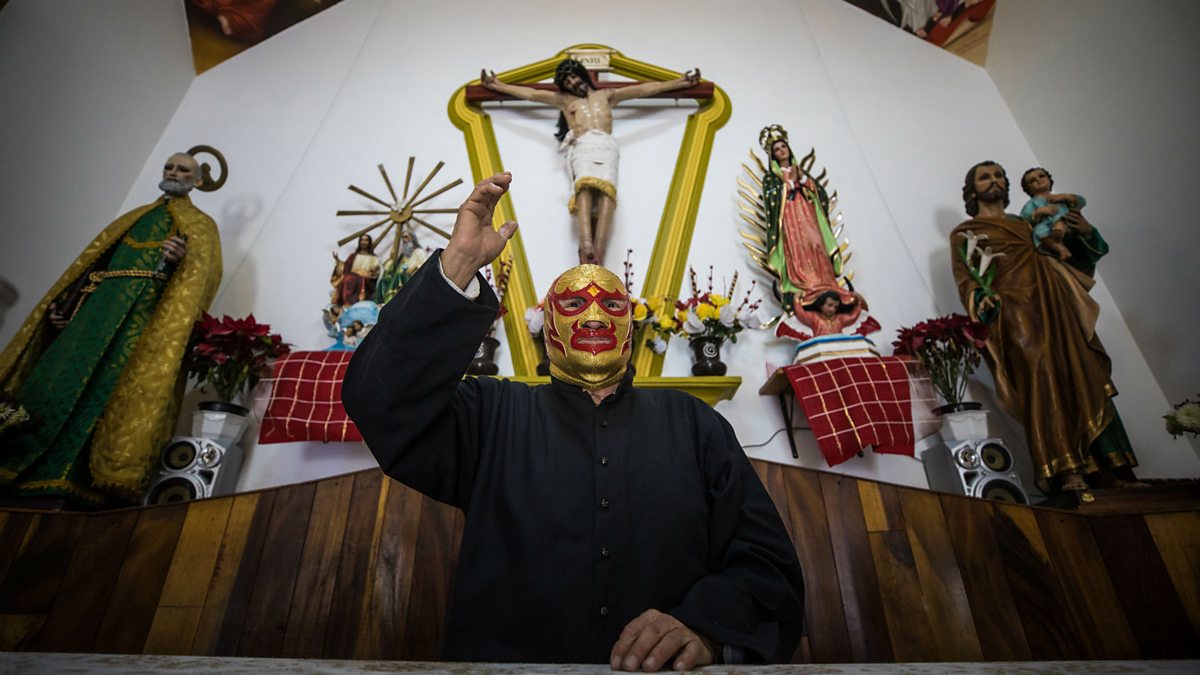The term Lucha Libre translates literally as “free fighting”. This is not an industry trying to convince us the combat is real. Luchadors are fighters in a broader sense. They fight for honour, for fame, for money, or just for the passion of their craft.
For Fray Tormenta, his cause may seem like the plot to a movie, but he fought for something greater than himself.
Sergio Gutiérrez Benítez was born in one of the smallest municipalities of Hidalgo, Mexico, on May 9, 1945. San Augustín Metzquititlán has never had a population that reached ten thousand people.
Yet most of the families that call it home had lived in poverty. Gutiérrez’ family was no different. He was the sixteenth child out of seventeen.

Yet he understood his dreams were just that; mere fantasies. Entertainment served as an escape from the reality that was his life. He only wanted to be rich and famous so he would not have to live in poverty forever.
Fray Tormenta – The Storm From The Shelter
His family kept moving around after the murder of their uncle. They eventually settled in Mexico City. Gutiérrez began experimenting with drugs and alcohol when he was ten years old.
During his teenage years, he became involved with gangs. Gutiérrez would be stabbed in multiple different incidents, and was shot in another.
Being too poor to afford medical treatment, and fearing prison, meant having to treat his injuries himself. By twenty-two, he was a full-blown addict. He earned money to feed his addictions by doing various odd jobs and winning street fights.

He finally realized he needed to change his life. He went to a local Roman Catholic chapel and begged for help.
Despite his unholy lifestyle, Gutiérrez was a theist. He was raised to believe in God by his parents. However, he was physically turned away by the church because he was a poor addict.
The agony of this rejection caused him to reflect upon a movie that inspired him. “El Señor Tormenta” (Mr. Storm) was about a Catholic priest who did various jobs to raise money for an underfunded orphanage.
There are thousands of people around the world who had been hurt by bad church leaders. Gutiérrez had the maturity to understand that a few bad doctors, teachers, or police officers did not mean their entire institutions were bad.
Similarly, one bad priest did not disprove his religion. Gutiérrez became determined to become a priest in line with the teachings of the Holy Bible. He wanted to become the kind of priest who helped poor people and those in need.
Perhaps if people saw priests being genuine examples of Christianity, they would avoid living the life he had led.
He entered himself into a rehabilitation clinic voluntarily. He was advised that it was a detoxification center. Being cured of his addictions depended entirely on himself.
The center did offer activities to help. Gutiérrez reignited his passion for music by joining a mariachi band. It was there he met one of his most important friends.
Once he had become clean, he entered the priesthood. He was kicked out of his first seminary after he punched another student. He corrected his behavior and conducted himself more professionally at his next seminary.
His studies took him to Rome and Spain. Gutiérrez would then spend years as a teacher of history and philosophy in universities across Mexico. His friend kept encouraging him to get fully ordained, but Gutiérrez felt it was unnecessary.
“How are you going to break a wild colt from night to morning?”
– Fray Tormenta on why he continued trying to join the priesthood after being kicked out of his first seminary [translated]
Gutiérrez was called to his first church. Within days of being installed in Vera Cruz, he was beaten in a bloody fight with a drug addict in a public setting. There is debate over whether this altercation was real or a publicity stunt.
In either case, seeing a bloodied priest refusing to back down won the respect of the local community. Just as he was about to become complacent, he got a brutal reminder that he had not completed his destiny.

After absolving his friend, he watched him pass away before him. He was still grieving when he requested to be fully ordained. His request was quickly granted.
He used his next church as a children’s home for young boys. He ignored instructions to stop taking in orphans and was ordered to leave. When he relocated to Texoco, he promptly set up an orphanage and relocated all the children he had adopted.
His new church allowed him to do this but insisted he fund the outreach himself. Running an honest ministry sometimes means running it at a financial loss.
He pleaded with the local community for donations and did the old just he had when he was an addict to raise money. Ultimately, he sought inspiration from Señor Tormenta once more.
The second movie in the series was “Tormenta En El Ring” (“Storm in the ring”), and was released in the same year. In this sequel, Señor Tormenta funds his orphanage through money he earned by secretly competing as a maxed wrestler. Gutiérrez would do the same.
When Gutiérrez tried to enter the industry, it was dominated by the Empressa Mexicana de Lucha Libre (now known as Consejo Mundial de Lucha Libre). You could only succeed if EMLL management wanted you to.
They were unwilling to push young talent, and refused to adapt to changing audience tastes. Gutiérrez was in his late twenties, had no experience, and a poor physique. The door was automatically closed to him.
Other small indy promotions did exist, many of them created in protest of the EMLL. But they were unable to get television deals or book larger arenas. They did not last long. Yet this was Gutiérreze’s only option.

They lasted longer than most because of their successful cross-promotion with US companies, including the World Wrestling Federation.
The UWA offered opportunities to the types of wrestlers that EMLL usually turned away. Gutiérrez would work most of his career matches there.
Gutiérrez chose to hide in plain sight. He became “Fray Tormenta” (Friar Storm). His character was a priest who wrestled for money to fund an orphanage. He would go to the ring wearing genuine papal robes.
Those who suspected he was an actual priest were dismissed as gullible. He wore gold with a red lightning motif. He said yellow parts represented life, and the red represented the blood he would have to shed. And there would be a lot of blood.
Fans and other wrestlers were amazed by Tormenta’s toughness and bloody brawls. Promoters liked putting him against wrestlers with demonic characters. Tormenta would win matches using a figure-four leglock he called “La Confecíonal”.
Opponents would have to beg for mercy “from God” in order to escape the hold. Tormenta’s matches often became morality plays where God usually triumphed over evil.
Tormenta had long gaps between his matches. These gaps could be a few weeks, months, or even exceed a year. This was partly due to his real-life commitments to his church and orphanage. The other was because he genuinely did not care for wrestling.
He only did it as a means for supporting his orphanage. At first, the money was far from what he had anticipated. Winning his first match reportedly earned him only $10 USD in today’s money.
The gaps meant he had few opportunities to improve. Nearly all his matches were six-man tag matches, often with the “Best two out of three falls” rule.
Another performer from UWA attended a mass service at Gutiérrez’ church. He recognised Gutiérrez from the arena locker room. Exposing another luchador’s true identity is taboo in Mexico. Yet this is what happened to Gutiérrez.
As he had anticipated, his Diocese instructed him to stop wrestling. They had forgotten about his toughness.
He told them that the only way he would stop wrestling was if they matched the money had earned. When they realized how impractical this was, they gave Gutiérrez their blessing to keep competing, but under stricter conditions.
Now that Tormenta’s secret was out, he instantly became more popular. He began seeing more people in attendance at his wrestling matches and church services.
He would rename his orphanage “La Casa Hoga de los Cachorros de Fray Tormenta” (or “The Children’s Home for Fray Tormenta’s Cubs).
His name alone brought in more donations. He also discovered a new Ministry with younger Catholic wrestlers coming to him for advice and mentorship.
The UWA closed in 1995. Tormenta was too old and too busy to start again anywhere new. He attempted to pass the mantle down to a protegee. One of the children he adopted was old enough to begin wrestling.
He donned a similar outfit and the name “Fray Tormenta, Jr.”. His identity has not been made public.
The older Fray Tormenta decided to keep wrestling a little longer to help get his protegee started. The pair competed as a tag team at a Wrestle Association-R (WAR) event in Tokyo, Japan.
Even though the UWA was created as a direct rival to CMLL, he would still compete there a few times. The first was in 1990, while the company was still known as EMLL.
He then returned in 1997 as he was becoming famous. Lucha Libre AAA Worldwide had been created as a rival to both CMLL and UWA.
Their conflict was between promoters, and not wrestlers. AAA still had a great respect for Tormenta and his mission. They were happy to have the veteran make occasional appearances for them.
Five years into his so-called retirement, Tormenta accepted he was not fully done. He reclassified himself as “semi-retired”.
Tormenta has competed in two Luchas de Apuestas matches. These contests carry a forfeit for the loser. He had put his mask on the line both times.
In the luchador tradition, the mask is sacred. Intentionally removing someone else’s mask can result in being disqualified, fined, suspended, and even barred in some Mexican promotions.
If a luchador removed their own mask publicly, then tradition dictated that they may never compete with it on again. It is safe to say this tradition has faded today. Fray Tormenta defeated Bugambilia in 1990.
As a penalty, the heel had his head shaved. In 2011, he pinned El Hijo de Judas, who was forced to unmask.
This result meant that X-Fly and Boy Danger were allowed to retain their masks, and Super Crazy and Bestia 666 kept their long hair.
On July 3, 2011, Tormenta competed at International Wrestling Revolution Group’s Festival de las Mascaras (“Festival of the Masks”) event. After his team won their match, he announced to the crowd that it would be his last.
He made one more appearance at a CMLL event a year later. This time, it was to give his blessing to Dragon Lee.
He claimed that Lee had impressed him during the En Busca de un ídolo tournament. He invited Lee to become his new protegee.
Lee immediately accepted and was awarded a new mask. He put it on and became the new Místico. The original Místico had recently gone to the WWE to compete as Sín Cara. Tormenta continues to appear as Mistico’s mentor in the comic book series Místico: El Principe de Plata y Oro.
“I sought The Lord and he heard me, and delivered me from all my fears.”
– Psalm 34:4, The Bible
In a case of life imitating art imitating life, Tormenta has been the subject of multiple movies. The first was the French language movie “L’Homme au masque d’or” (“The Man in the Golden Mask”) in 1991.
Jean Reno played Father Victorio Gaetano. By far, the most famous adaption was the comedy ‘Nacho Libre’ in 2006. The film was produced by and co-starred Jared Hess, the creator behind Napoleon Dynamite.
Jack Black played the titular role alongside Hess and Winona Ryder. Fray Tormenta cameoed as a retired luchador, while his real-life friend Silver King portrayed the main villain Ramses.
The WWE’s main website helped promote the movie by adding the main character to the SmackDown roster page for a month.
The entire movie was filmed in Mexico using locals as actors and extras. A year later, Tormenta played himself in “Padre Tormenta”, a Spanish-language movie based on his life.
All three movies featured a scene where the main character was ex-communicated from the church after his secret was revealed.
The real-life Tormenta did not care for living his childhood fantasy of being an actor. He did it simply as a means of gaining more help for the children in his care.
Tormenta has also been the inspiration for multiple video game characters. The most notable being King and King from the Tekken fighting-game series.
In the first two games, King is a former priest who was ex-communicated when the church learned he earned funding for the orphanage by competing in wrestling and street fights.
In both game endings, he uses his prize money to buy presents for kids at the orphanage. According to the lore, he is killed by Ancient Ogre in between the events of the second and third game. This leads to one of his foster kids taking on the King identity.
While the younger King seems more concerned about winning championships and preserving his mentor’s legacy, he is still depicted as raising money for his former orphanage in other forms of Tekken media. The appearance and fighting style of both Kings is heavily based on Tiger Mask.
Crasher Wake is a gym owner (boss) in Pokémon: Diamond, Pearl, and Platinum. Leon is a racer in the F-Zero racing games.
Both characters are masked wrestlers who used money earned from wrestling and their other main sport/profession to raise money for an orphanage.
In the Chrono Cross role-playing game, Greco is a former Mexican wrestler whose appearance is directly based on Tormenta. Only minor changes are made to avoid potential lawsuits.
After his secret was exposed in the mid-90s, Fray Tormenta conducts most of his papal duties with his wrestling mask on. He is also the spiritual advisor for numerous luchadors, particularly within the AAA.
Marco Corleone (Mark Jindrak) went to Tormenta for his children’s baptisms. In 2021, the Mexican wrestling community was shocked by news that he had been hospitalized.
At the time of writing, the 78-year-old is doing well. He may have reduced his workload, but he is still dedicated to his church and outreach.
Fray Tormenta has left a tremendous legacy for someone who achieved so little in the ring. He never held or even challenged for any championships. He only has twenty-three documented matches.
It is unknown how many matches he has had in total, but Fray Tormenta himself believes the number to be fewer than fifty.
While he spent little time fighting in the ring, he has fought every single day of his life. He keeps fighting to help make sure the most vulnerable in his community will not have to face the same battles.









